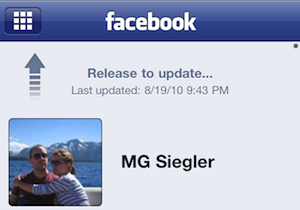

Then nice clients came out, like Twitterrific (great for just reading the stream, invented "tweet" and the bird icon, his name is Ollie), Twittelator (great for lists and filtering), and Tweetie (neat UI design, invented pull-to-refresh). The normals hadn't really found their way there yet.Īt first there was just a little post form on a page, and you had to reload to get updates. WWDC lunch & event planning, and other nerds finding our weird Objective-C hobby useful and profitable, and all the weird social events which even antisocial nerds would enjoy because it was software-mediated. And then put a banner in front of my notifications (which I still see even if I don't read my timeline), so I said fuck it and hit post, made the swamp a little shittier.īut. To alleviate these patent problems, Twitter agreed to only use his patent defensively - the company wouldn’t sue other companies that were using pull-to-refresh in apps unless those companies sued first.īrichter knew he had invented something valuable which would cause him to take a bullet in the chamber.A day that will live in infamy: Twitter emailed me to make sure I knew I joined Twitter 11 years ago today (really?). While applying for the patent, Brichter was worried about the rampant abuse of patents in the tech industry. The patent was granted to Loren Brichter who introduced the gesture to Twitter when it acquired Tweetie developer Atebits back in 2010. In 2013, Twitter was granted a patent for the pull to fresh feature which was named as ‘user interface mechanics’.

Every tech company under the sun has numerous patents at their disposal, why run after this one? Its simple to guess, it all comes down to the nature of the interaction being published. Patenting the pull to refresh gesture did not catch attention for no reason. Brichter believed it was crucial to provide users with visual feedback, so the second and final iteration of pull to refresh added visual feedback when refreshing so users could better understand the gesture.Ī single afternoon is all it took to invent these two pull to refresh gesture that too without any user testing.Īfter its initial release in 2008, the interaction designers from the design communities created an evolution for pull to refresh by adding their own styles and techniques. However, in this iteration there was no visual effects that signaled users about a refresh occurring. In the first iteration, users triggered the refresh when they scrolled across an invisible threshold on the screen. Brichter thought this was the most prime spot for navigation and action UI, so occupying it up for something as mundane as a refresh button just seemed wasteful.īrichter then brainstormed to create a different method of refreshing and thus developed the ‘Pull to refresh’ feature. Usually this button would be cramped in a toolbar bordering a scroll list. Others developers would find a spot somewhere on the app screen to fit in the button. Just like any other application, Brichter was trying to fit in a refresh button to the application. Isn’t it always good to give the user what they want, at their own convenience and without them asking for it? This is exactly what Loren Brichter did with Tweetie. It is a touch screen gesture where you touch the screen of the device with a finger or pressing a button on a pointing device, dragging the screen downward with the finger or pointing device, and then releasing it, this is a indication for the application to refresh the content on the screen. Today, almost majority of the famous apps use the ‘Pull to refresh’ feature. This gesture was first introduced by Loren Brichter in the Tweetie app and in no time it gauged popularity amongst countless apps. Pull to refresh or swipe to refresh pattern lets a reader retrieve new data simply by using touch. It’s a feature that feels so obvious, so natural, and so much like the way things are supposed to work.

Both these members have to work in a synchronize to develop a pull to refresh gesture that is alluring with minimalist design and keeps the user entertained while they wait. As minor as it may seem, every element of the designing and its placement has to be thought through before implementation.Īt times you may have designers who offer extraordinary ideas but the developers may not be able to execute it. How do we save time and retrieve new data on our smartphone? With a simple gesture called pull to refresh. Pull down to refresh_Freebie by Hanna Jung


 0 kommentar(er)
0 kommentar(er)
